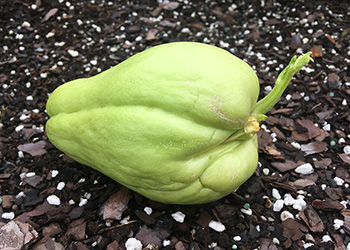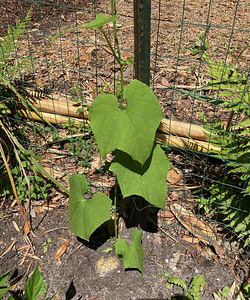Chayote

A chayote fruit beginning to sprout. Photo: Tia Silvasy, UF/IFAS.
Chayote is a heat-loving, tropical vegetable, perfect for Florida's steamy summers. It's also known as the vegetable pear, mirliton, and mango squash.
Characteristics
Native to Guatemala, chayote (Sechium edule) is a cucurbit. It is closely related to melons and squashes. Chayote leaves, in fact, look a lot like cucumber leaves. The growth habit is very different, however. Chayote vines climb and require support. Gardeners often trellis them on an arbor so they can harvest in the shade.
Chayote is monoecious, meaning it produces separate male and female flowers. Wasps and bees visit the flowers, pollinating them. Fruits will develop from the female flowers about 35 days after they are pollinated.
Like other climbing vines, chayote bears its fruits above ground level. The light green, pear-shaped fruit weighs between six ounces to three pounds. Each holds a single, flat, edible seed. Sometimes the fruit is grooved and prickly, but those grown in Florida are usually smooth. 'Florida Green' and 'Monticello White' are the most common varieties.

Planting and Care
To sow chayote seed, gardeners plant an entire fruit. Dig a hole as deep as the fruit is wide. Lay the fruit in the hole, on its side, with the narrower end sloping upward. Leave the stem end exposed in Central and South Florida. In North Florida, covering the fruit completely will protect the bud from unexpected cool weather.
Sow chayote in the early spring anywhere in the state. In South Florida you can also plant in the fall. Fertilize the plants 30 days after planting, once the vine is a few feet tall. You may need to fertilize again in mid-summer and when the fruits are small. A soil test can help you decide what amendments are necessary. Compost and other organic soil amendments are also helpful.
Harvest chayote fruits young and the seed and rind will be soft and edible. The fruit is still edible but tougher when it begins to sprout. Once established, chayote will come back every year. Like many perennial vegetables, the best yields happen after the plant is 2-3 years old.
Chayote has a texture similar to mature zucchini. To cook this vegetable, treat it as you would winter squash. Cooks prepare it roasted, creamed, buttered, fried, baked, frittered, boiled, or mashed. It is also served in salads, pies, and pickles. For questions about food preparation and safety, consult a Family and Consumer Sciences Extension Agent at your county Extension office.

Chayote vine climbing fence. Photo: Tia Silvasy, UF/IFAS.
For more on adding chayote to your garden contact your county Extension office.

